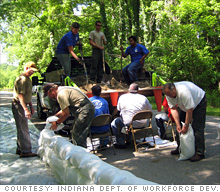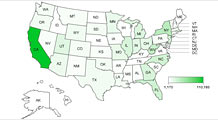$1.2 billion for summer jobs
Stimulus funds provide job training for disadvantaged young adults. Programs intended to build skills, but some states may find it tough to place participants.
 |
| Young adults help improve Indiana's parks thanks to federal stimulus funds. |
NEW YORK (CNNMoney.com) -- With teen summer employment expected to hit its lowest level since 1948, the federal government is pumping $1.2 billion in stimulus money into job training programs for youth.
The funds are aimed at providing disadvantaged 14-to-24-year-old youth with job training skills and schooling to better prepare them to continue their education or enter the workforce.
States are now implementing summer work programs to put their funding to use. Some are devising brand new efforts to train young adults, while others are expanding existing initiatives. The workers, who must be low income and meet certain at-risk criteria such as being a dropout or disabled, will be paid at least minimum wage.
The youth training program is getting a considerable portion of the $4 billion in stimulus funds set aside for job training. The rest of the funds are going to help unemployed adults get back to work.
"We also have to invest in our young people to make sure they gain work experiences for the future," said a senior Department of Labor official. "Hopefully it can put them on the path to working or returning to school better prepared."
The stimulus funds reverse a long decline in federal support for such endeavors. In fiscal year 2009, the government set aside $1 billion for youth workforce funding, down from $1.5 billion eight years earlier. Meanwhile, summer youth employment rates have been falling for much of the decade as 20-somethings and retirees vie for jobs that typically went to teens.
"Summer employment has been an access point for youth to learn basic workforce skills," said Jonathan Larsen, policy associate with the National Youth Employment Coalition. "These skills are very important to employers."
Youth training programs are a key element in assisting disadvantaged young adults secure and maintain employment, which often translates into a better paycheck throughout their lives, said Joe McLaughlin, senior research associate at the Northeastern Center for Labor Market Studies. Such initiatives also encourage many youth to continue their education.
Only 51.4% of the high school dropouts were in the labor force in 2006, compared to 76.4% of recent graduates, according to the U.S. Census Bureau.
In Spokane, Wash., for instance, more 18-to 24-year-olds are coming to local career centers saying they cannot find jobs, said Dawn Karber, youth program and development manager for the Spokane Area Workforce Development Council. And more high schoolers are having trouble finding part-time work.
"For kids with barriers, finding employment is already difficult," she said. "In this economic environment, it's increasingly hard."
The recession, however, could make it tough to find positions for the young adults. Even though the feds are providing the funds, companies, governments and nonprofits may be reluctant to participate. "They may have a hard time finding supervisors to manage the summer jobs programs," McLaughlin said.
Harkening back to the Civilian Conservation Corps of the Great Depression, Indiana is hiring 2,000 young adults to form the Young Hoosiers Conservation Corps. The state launched the initiative specifically for the $21 million in youth stimulus funds it is receiving.
Participants, who will earn $8.50 an hour for 16 weeks, will build trails, restore Department of Natural Resources properties and rehabilitate historic buildings at recreation areas, state forests and parks.
If successful, the effort will continue next summer with the remaining funds.
The Hoosier State created the conservation program because officials wanted to use the federal funds to make tangible improvements. The corps are expected to build up to 110 miles of new trails, rehabilitate more than 1,100 miles of existing trails and restore 2,600 acres of natural habitats and 40 structures.
"The governor wanted to leave a lasting legacy, something that will outlive the stimulus dollars," said Marc Lotter, a spokesman for the Indiana Department of Workforce Development.
In Spokane, which is receiving $1.8 million, participants will get time on the job, as well as in the classroom. Those without high school diplomas will study for their GEDs, while working part-time. Those who finished school will split their summer on the job and in an education program, such as vocational training at a community college.
In addition, the participants will learn workplace ethics, social skills, resume writing and interviewing techniques.
More than 400 young adults will be placed at more than 70 employers and will earn $8.55 an hour. For instance, the city is creating a certified nursing assistant program, where young adults will earn credentials, while assisting in the care of patients. Others will be placed at Goodwill Industries, where they will recycle donated computers.
"We're trying to put kids into good training positions so that when the leave, they will be competitive in the workforce," said Karber.
Summer jobs can help young adults figure out what careers are right for them, said Jeanne Mullgrav, commissioner of the Department of Youth and Community Development in New York City.
The city will spend $18.5 million of its $29 million allotment to provide paid summer jobs to 13,378 young adults for seven weeks, allowing it to serve a total of 51,000 youth this summer. The remaining funds will support paid year-round internships and training.
Some assigned to camps may find they don't want to work with children. Others who work in city agencies may discover public service is for them, Mullgrav said.
"You learn not only what you like to do, but what you don't like to do," she said. ![]()


